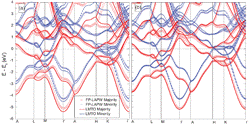Department of Physics and Astronomy: Publications and Other Research

Kirill Belashchenko Publications
Document Type
Article
Date of this Version
4-2004
Citation
Journal of Magnetism and Magnetic Materials 270:3 (April 2004), pp. 413–424.
doi:10.1016/j.jmmm.2003.09.017
Abstract
Using the spin-spiral formulation of the tight-binding linear muffin-tin orbital method, the principal components of the exchange stiffness tensor are calculated for typical hard magnets including tetragonal CoPt-type and hexagonal YCo5 alloys. The exchange stiffness is strongly anisotropic in all studied alloys. This anisotropy makes the domain wall surface tension anisotropic. Competition between this anisotropic surface tension and magnetostatic energy controls the formation and dynamics of nanoscale domain structures in hard magnets. Anisotropic domain wall bending is described in detail from the general point of view and with application to cellular Sm–Co magnets. It is shown that the repulsive cell-boundary pinning mechanism in these magnets is feasible only due to the anisotropic exchange stiffness if suitably oriented initial pinning centers are available. In polytwinned CoPt-type magnets the exchange stiffness anisotropy controls the orientation of macrodomain wall segments. These segments may reorient both statically during microstructural coarsening and dynamically during the macrodomain wall splitting in external field. Reorientation of segments may facilitate their pinning at antiphase boundaries.
Included in
Atomic, Molecular and Optical Physics Commons, Condensed Matter Physics Commons, Engineering Physics Commons, Other Materials Science and Engineering Commons, Statistical, Nonlinear, and Soft Matter Physics Commons


Comments
Copyright © 2003 Elsevier B.V. Used by permission.